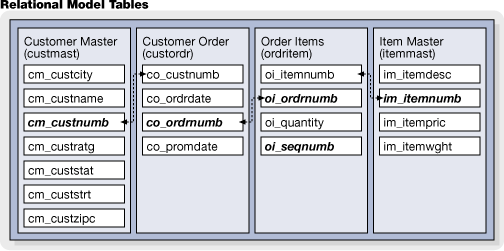php.sql\tutorials\PHP_Tutorial2.php
Now we will build some table/file relationships using the FairCom DB PHP Interface.
This tutorial will advance the concepts introduced in the first tutorial by expanding the number of tables. We will define key columns/fields and create specific indexes for each table to form a relational model database.
Like all other examples in the c-tree tutorial series, this tutorial simplifies the creation and use of a database into four simple steps: Initialize(), Define(), Manage(), and You’re Done() !
Tutorial #2: Relational Model and Indexing
Here we add a bit more complexity, introducing multiple tables, with related indices in order to form a simple "relational" database simulating an Order Entry system. Here is an overview of what will be created:

Note our simple PHP script:
<?php
print("<html>\n");
print("<head>\n");
print("\t<title>PHP Tutorial 2</title>\n");
print("</head>\n");
print("<body>\n");
//
// Implementation of the concept of "init, define, manage and you're done..."
//
$session = Initialize();
Defines($session);
Manage($session);
Done($session);
We suggest opening the source code with your own editor.
Continue now to review these four steps.